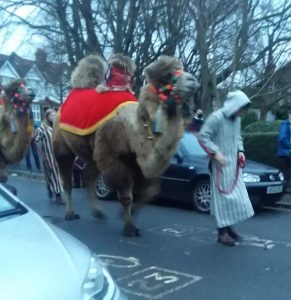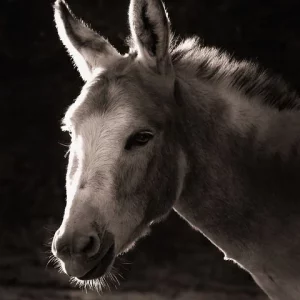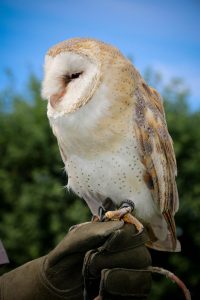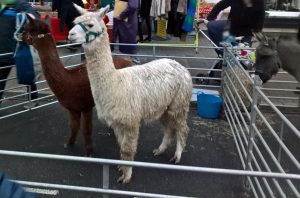Which Animals are used in Festive Events?
Festive events can be stressful for any animal. Animals used include reindeer, donkeys, horses, ponies, birds of prey (including owls), camels and many other animals (including piglets, lambs, sheep, alpacas, goats, penguins, dogs and llamas).
Why can festive events be stressful for animals?
- Festive events frequently attract large crowds of noisy and excitable people, who demand interaction with animals present. All-too-often, the animals are given nowhere to retreat to and the unfamiliar surroundings are likely to be frightening for any animal.
- The Animal Welfare Act 2006 states that reasonable steps should be taken to meet an animal’s needs, including the need for a suitable environment and need to be able to exhibit normal behaviour patterns. Festive events venues rarely meet these needs, for example, animals are often forced to stand in small enclosures, on hard surfaces, with little enrichment for hours on end. These environments are vastly different from their natural habitat.
- Transportation to the event can be stressful and may take several hours. Animals are often subjected to an extensive schedule, which can sometimes involve traveling to more than one event on the same day.
Most festive parades and displays using animals, involve live reindeer. Find out issues specifically affecting reindeer used in festive events here.
Report a festive event using live animals Camels
Camels
Travelling circuses have been banned from using camels in the UK as they are classed as wild animals. However, they still can be transported up and down the country to be paraded a long a busy street or used as props for a nativity scene in a crowded church.
Camel Welfare Issues
- Camels are social animals, who are used to living in large herds and have evolved to live in an arid environment, in a climate vastly different from the UK.
- Experts on camel behaviour have stated these sensitive animals can become stressed in unfamiliar surroundings and during transportation.
- Even well-trained keepers can find it hard to tell when camels are stressed, ill or injured.
Public Safety Issues
- When stressed, camels can become aggressive and inflict fatal injuries due to their size and strength.
- Humans can contract brucellosis, ringworm, and tuberculosis from interaction with camels.
“Even under the best of circumstances, captivity is cruel for camels. Confined to tiny areas and gawked at by crowds, animals in exhibits and acts endure constant stress. They may suffer from temperature extremes and irregular feeding and watering. Without exercise, they become listless, their immune systems are weakened, and they become prone to sickness; many resort to self-mutilation in reaction to stress or boredom. Mental illness is rampant among confined animals. Torn from their families and deprived of all dignity, every part of their lives is controlled by their captors”.
World Animal Foundation
Donkeys
Live donkeys are sometimes used in nativity plays in crowded churches or other venues in the run up to Christmas. Children are sometimes allowed to ride on them at festive events. 
Animal Welfare Issues
- Donkeys are known to mask signs of distress, so their suffering can easily go unnoticed.
- Donkeys have a reduced flight response and so it can be extremely hard to read their body language and know when they are frightened or unwell.
- Transportation and change of environment can be incredibly stressful for donkeys.
- Donkey’s skin does not produce as much natural grease as certain other animals and so they may be more susceptible to weather conditions such as rain, wind and snow. As a result, they always need access to suitable shelter, which may not be available at event locations.
“The Donkey Sanctuary does not endorse or encourage the use of donkeys or their hybrids (mules and hinnies, herein described as donkeys) in any form of entertainment.”
The Donkey Sanctuary in Sidmouth, a well-trusted authority on donkey welfare.
Birds of Prey
Birds such as hawks, falcons, eagles and owls are kept in cavity and can be taught to perform stunts for the entertainment of crowds of people, such as at festive events. They are deprived of the ability to display many of their natural behaviours, such as the right to fly as and when they wish.

Animal Welfare Issues
- Festive events attract large crowds. Some keepers allow direct contact between the public and birds during displays. The constant touching and stroking of birds can be stressful for the birds and can also damage their feathers.
- Elevated levels of noise from large crowds and sometimes loud music at festive displays, may cause distress to birds of prey. These animals have overly sensitive hearing to enable them to hear their prey.
- A sudden loud noise or movement, from the often-unpredictable public, can startle a bird and cause them to attempt to fly from the falconer’s glove or perch. This could result in injury and pain to the legs and feet of a bird.
- A 2018 investigation by Freedom for Animals (FfA) into birds of prey kept in captivity in the UK, uncovered widespread failings and animal suffering. FfA found three quarters of birds were permanently tethered (tied down), when not flown during displays. They also found birds living in cramped conditions which did not meet the legal aviary size, a lack of access to clean drinking water and evidence of stress in birds, such as chewing at leg straps and beak clapping. FfA also found birds starved of food by handlers for several days, in a method frequently used by the industry to make them perform certain behaviours.
Mobile farms
Mobile farms can appear at festive events, such as Christmas light switch-ons in high streets. They often include various animals such as piglets, lambs, sheep, alpacas, llamas, goats, guinea pigs and rabbits.
Animal Welfare Issues
 Throughout the year, animals in mobile farms are transported from event to event, often in small cages. Just before busy periods, such as Christmas, they can travel many miles, each day, without being allowed to rest in between. This may have severe consequences for their health and wellbeing.
Throughout the year, animals in mobile farms are transported from event to event, often in small cages. Just before busy periods, such as Christmas, they can travel many miles, each day, without being allowed to rest in between. This may have severe consequences for their health and wellbeing. - At busy events, animals are often repeatedly touched and sometimes handled, by a constant stream of visitors. The animals usually have nowhere to hide and therefore get no rest. Even when there are signs asking the public not to touch the animals, these are frequently ignored and with large crowds, this can be difficult to enforce.
- Many animals are naturally nervous, such as guinea pigs and rabbits, and can suffer from stress due to unwanted interactions and elevated levels of noise, which is especially common at festive events.
- Many mobile farms only use the “cutest” looking animals to attract crowds. When animals get older, they may be discarded or even killed.
Public Safety Issues
- The risk of transmission of dangerous bacteria, such as E. coli, from animals to humans is high when the public have direct contact with animals.
“Farm animals can be the source of several bugs that can be passed from animals to humans and cause illness. Some can be particularly serious for children or pregnant women.”
Public Health England 2019
Please do not support events which use live animals. Find out how you can help our campaign against animals used in festive events:
Take Action for Animals Used in Festive Events